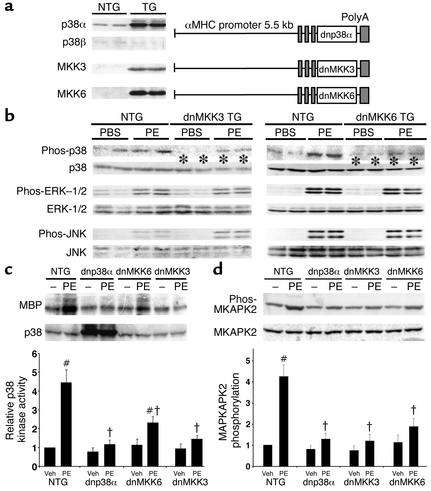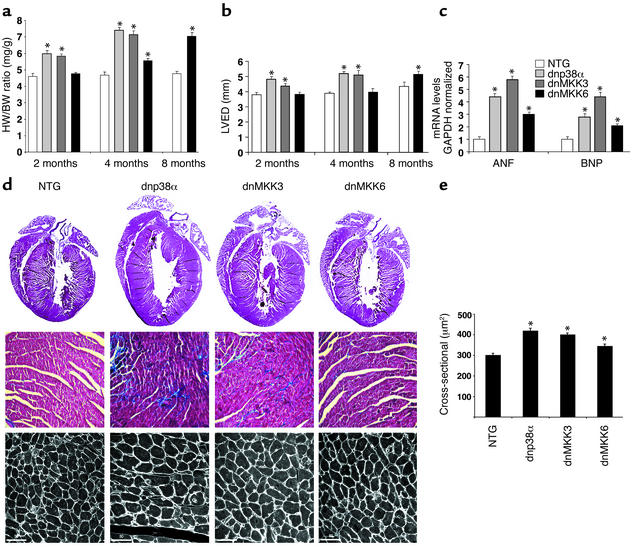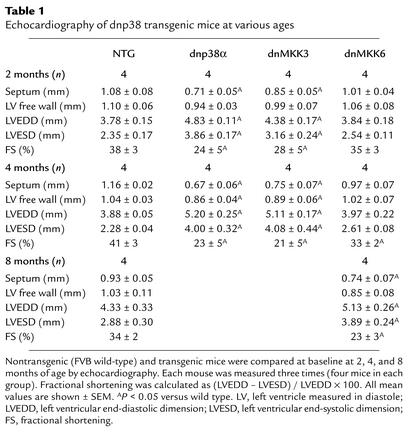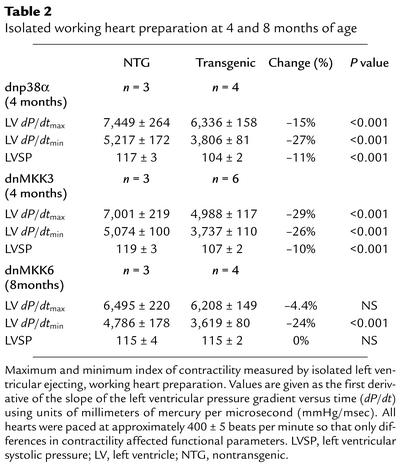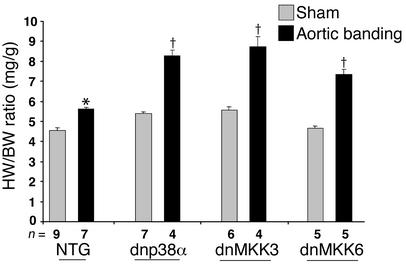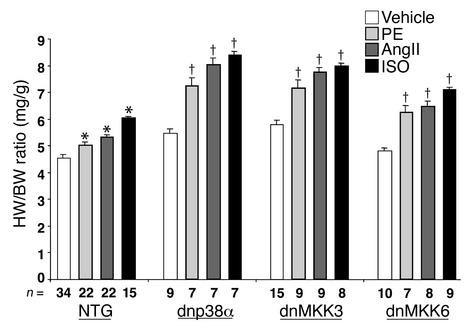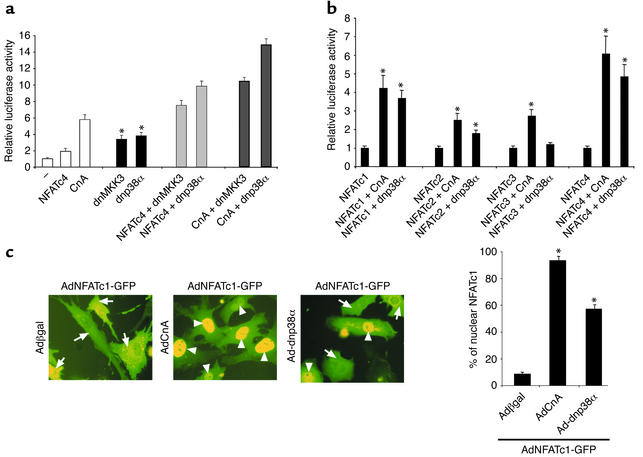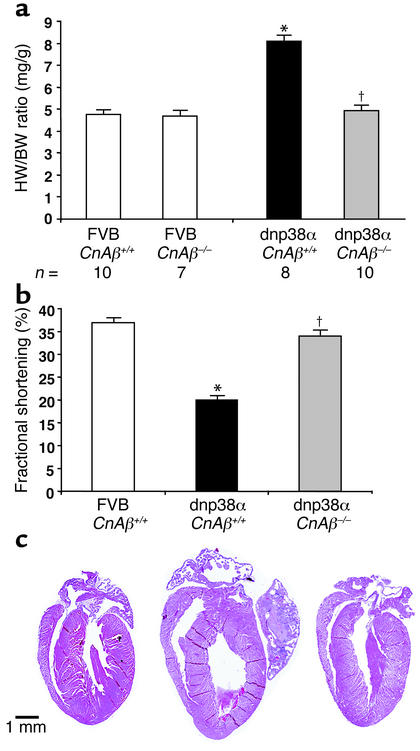Abstract
The MAPKs are important transducers of growth and stress stimuli in virtually all eukaryotic cell types. In the mammalian heart, MAPK signaling pathways have been hypothesized to regulate myocyte growth in response to developmental signals or physiologic and pathologic stimuli. Here we generated cardiac-specific transgenic mice expressing dominant-negative mutants of p38α, MKK3, or MKK6. Remarkably, attenuation of cardiac p38 activity produced a progressive growth response and myopathy in the heart that correlated with the degree of enzymatic inhibition. Moreover, dominant-negative p38α, MKK3, and MKK6 transgenic mice each showed enhanced cardiac hypertrophy following aortic banding, Ang II infusion, isoproterenol infusion, or phenylephrine infusion for 14 days. A mechanism underlying this enhanced-growth profile was suggested by the observation that dominant-negative p38α directly augmented nuclear factor of activated T cells (NFAT) transcriptional activity and its nuclear translocation. In vivo, NFAT-dependent luciferase reporter transgenic mice showed enhanced activation in the presence of the dominant-negative p38α transgene before and after the onset of cardiac hypertrophy. More significantly, genetic disruption of the calcineurin Aβ gene rescued hypertrophic cardiomyopathy and depressed functional capacity observed in p38-inhibited mice. Collectively, these observations indicate that reduced p38 signaling in the heart promotes myocyte growth through a mechanism involving enhanced calcineurin-NFAT signaling.
Introduction
Cardiac hypertrophy is characterized by an enlargement of the heart associated with an increase in cardiomyocyte cell volume and the re-expression of certain fetal genes. Hypertrophic growth of the adult myocardium can occur in response to diverse pathophysiologic stimuli such as hypertension, ischemic heart disease, valvular insufficiency, and cardiomyopathy (reviewed in ref. 1). While cardiac hypertrophy is thought to initially benefit the heart by maintaining or augmenting pump function, prolongation of the hypertrophic state is a leading predictor for the development of arrhythmias, sudden death, and heart failure (2, 3). Current pharmacologic treatment strategies for cardiac hypertrophy involve antagonism of key membrane-bound receptors that respond to such neuroendocrine stimuli as Ang II, endothelin-1, and catecholamines (4).
The MAPK signaling cascade represents an attractive intermediate signal transduction cascade for pharmacologic intervention given its characteristic activation in response to most hypertrophy-associated stimuli (5). In its broadest sense, the MAPK signaling cascade consists of a series of successively acting kinases comprised of three main branches; extracellular signal-regulated kinases (ERKs), JNKs, and p38 kinases (5, 6). Data implicating p38 and its upstream regulatory kinases MKK3 and MKK6 as effectors of the hypertrophic response have largely been obtained in cultured neonatal rat cardiomyocytes. Pharmacologic inhibition of p38 kinase activity with the antagonists SB203580 or SB202190 was shown to attenuate agonist-stimulated cardiomyocyte hypertrophy in culture under certain conditions (7, 8). In addition, adenoviral-mediated gene transfer of dominant-negative p38β (dnp38β) blunted the growth response of neonatal cardiomyocytes (9), and pharmacologic or dominant-negative inhibition of p38 significantly reduced agonist-induced B-type natriuretic peptide (BNP) promoter activity in vitro (10, 11). Similarly, overexpression of activated MKK3 or MKK6 in neonatal cardiomyocytes was shown to induce hypertrophy and atrial natriuretic factor (ANF) expression in vitro, further implicating p38 in the myocyte growth response (7–9). In contrast, other studies have concluded that p38 inhibition is not sufficient to attenuate all aspects of agonist-induced cardiomyocyte hypertrophy, suggesting a more specialized role for p38 MAPK signaling in vitro (12–14). More importantly, overexpression of either activated MKK3 or MKK6 by transgenesis in the mouse heart did not induce hypertrophic growth, suggesting that p38 activation is not causal in the cardiac growth process in vivo (15).
Considering the somewhat discordant data discussed above, it was of interest to determine the necessary function of p38 as a mediator of cardiac hypertrophy in the intact heart. Accordingly, here we generated cardiac-specific transgenic mice that express dnp38α, dominant-negative MKK3 (dnMKK3), and dnMKK6. Each transgenic line was viable and demonstrated a significant reduction in basal p38 activity, as well as agonist-induced p38 activation. Remarkably, each of the three dominant-negative transgenic strategies promoted cardiac hypertrophic growth at baseline or enhanced stimulus-induced cardiac hypertrophy. A mechanism underlying this phenotype is suggested by the observation that p38 directly regulates nuclear factor of activated T cells (NFAT) transcriptional activity in cultured cardiomyocytes and in the adult heart.
Methods
Generation of transgenic mice.
cDNAs encoding dnp38α (TGY→AGF mutation), dnMKK3 (S 189/193 A), and dnMKK6 (S 207/211 A) (gift from J. Han, Scripps Research Institute, La Jolla, California, USA) were subcloned into the murine α-myosin heavy chain (α-MHC) promoter expression vector (gift from Jeffrey Robbins, Children’s Hospital, Cincinnati, Ohio, USA). NFAT-luciferase reporter mice were generated by subcloning the minimal α-MHC promoter (+12 to –164) into the luciferase reporter plasmid pGL3-basic (Promega Corp., Madison, Wisconsin, USA). Subsequently, nine copies of the NFAT-binding site from the IL-4 promoter (5′-CTAGCTACATTGGAAAATTTTATACACG) were sequentially cloned immediately upstream of the α-MHC promoter into the NheI, MluI, and SmaI sites to generate 9×NFAT-TATA-luciferase. The calcineurin Aβ gene–targeted mice were described previously (16, 17). Experiments involving animals were approved by the Institutional Animal Care and Use Committee.
Echocardiography and isolated working mouse heart preparation.
Mice from all genotypes or treatment groups were anesthetized with isoflurane, and echocardiography was performed using a Hewlett Packard 5500 instrument with a 15-MHz microprobe. Echocardiographic measurements were taken on M-mode in triplicate from four separate mice per group. The isolated ejecting mouse heart preparation used in the present study has been described in detail previously (18).
Surgical models.
Two-month-old nontransgenic (FVB/N), dnp38α (FVB/N), dnMKK3 (FVB/N), and dnMKK6 (FVB/N) mice were subjected to abdominal aortic banding as described previously (17). Alzet miniosmotic pumps (no. 2002; Alza Corp., Mountain View, California, USA) containing either isoproterenol (ISO) (60 mg/kg/day), phenylephrine (PE) (75 mg/kg/day), Ang II (432 μg/kg/day), or PBS (control) were surgically inserted dorsally and subcutaneously in two-month-old mice under isoflurane anesthesia. All mice were sacrificed 2 weeks later.
Western blot analysis.
Protein samples were prepared from heart tissue using extraction buffer as described previously (19). Western blotting conditions were described previously (19). Ab’s included phospho-p38, p38, phospho-JNK, JNK, phospho–ERK-1/2, ERK-1/2, phospho-MAPKAPK2 (Cell Signaling Technology, Beverly, Massachusetts, USA), p38α, p38β, MKK3, MKK6 (Santa Cruz Biotechnology Inc., Santa Cruz, California, USA), and GAPDH (Research Diagnostics Inc., Flanders, New Jersey, USA). The specificity of the p38β Ab was verified by Western blotting from cardiomyocytes infected with adenoviruses encoding either wild-type p38α or p38β.
In vivo kinase assay.
Protein samples were prepared from heart tissue using TLB buffer [20 mM Tris-HCL, pH 7.4, 137 mM NaCl, 25 mM sodium β-glycerophosphate, 2 mM sodium pyrophosphate, 2 mM EDTA, 1 mM sodium vanadate, 10% (vol/vol) glycerol, 1% (vol/vol) Triton X-100, 1 mM PMSF, 5 μg/ml leupeptin, 5 μg/ml aprotinin]. Two micrograms of agarose-conjugated p38 anti-serum (Santa Cruz Biotechnology Inc.) was added to 500 μg of cell lysate in 400 μl TLB buffer. Immunoprecipitation was performed overnight at 4°C on a rotating platform. The beads were washed three times with 1 ml of TLB buffer, then with 1 ml KB buffer (25 mM HEPES, pH 7.4, 25 mM sodium β-glycerophosphate, 25 mM MgCl2, 0.1 mM sodium vanadate, 0.5 mM DTT). The protein kinase assay was performed by adding 10 μg of dephosphorylated myelin basic protein (MBP) and 50 μM [γ-32P]ATP (10 Ci/mmol) to approximately 10 μl of compacted protein beads in a total volume of 25 μl (KB buffer). The reaction mix was incubated at 30°C for 30 min and examined by 10% (wt/vol) SDS-PAGE.
Reporter assays in cultured cells.
Rat neonatal cardiomyocytes or 10T1/2 fibroblasts were transiently transfected using FuGENE 6 reagent (Roche Applied Sciences, Indianapolis, Indiana, USA) in 6-cm plates with 3 μg of DNA and harvested 24 h later for measurement of luciferase activity using a kit (Promega Corp.). The NFAT site-dependent luciferase reporter plasmid in pGL3-basic was described above.
Replication-deficient adenovirus.
The construction, characterization, and procedures for cardiomyocyte infections with replication-deficient adenovirus were performed as described previously (20). A cDNA-encoding dnp38α was cloned into the HindIII site of pACCMVpLpA, which was cotransfected into HEK293 cells with pJM17 (20). Cardiomyocytes were infected with each virus at a MOI of 50 plaque-forming units for 2 h at 37°C in a humidified, 6% CO2 incubator. The constitutively active calcineurin adenovirus (AdCnAΔ), the NFATc1-GFP adenovirus, and the NFATc3-GFP adenovirus were each described previously (20–22). We thank R.B. Marchase (University of Alabama at Birmingham, Birmingham, Alabama, USA) and M.F. Schneider (University of Maryland, Baltimore, Maryland, USA) for the gift of these NFAT-GFP–encoding adenoviruses. Under these conditions approximately 98% of the cells showed expression of the viral gene insert.
Histological analysis and hypertrophic marker gene analyses.
Hearts were collected at the indicated times, fixed in 10% formalin containing PBS, and embedded in paraffin. Serial 5-μm heart sections from each group were analyzed. Samples were stained with H&E, Masson’s trichrome, or wheat germ agglutinin-TRITC conjugate at 50 μg/ml to accurately identify sarcolemmal membranes so that myofiber diameter could be quantified (23). Cardiac gene expression of hypertrophic molecular markers was assessed by RNA dot-blot analysis as described previously (24).
Statistical analysis.
The results are presented as means plus or minus SEM. Data analyses were performed using InStat 3.0 software (GraphPad Software for Science Inc., San Diego, California, USA) or by ANOVA and regression analysis with perfused heart studies (Statview 5.01).
Results
Generation of dnp38 transgenic mice.
To begin to understand the necessary functions of p38 in the intact heart, we generated a series of cardiac-specific transgenic mice expressing dominant-negative mutants of p38α, MKK3, and MKK6 under the regulation of the α-MHC promoter. Each dominant-negative mutation has been characterized previously for its ability to specifically reduce p38 activity (25). Three, two, and five independent transgenic founder lines were generated for dnp38α, dnMKK6, and dnMKK3, respectively. Among these independent lines, one each was selected for further analysis based on comparable expression levels, viability, and germline transmission considerations. Using Ab’s specific for p38α, MKK3, or MKK6, six- to eightfold overexpression of each factor was observed in the hearts of transgenic mice at 2 months of age (Figure 1a). Overexpression of the dnp38α protein did not alter the minimal levels of endogenous p38β protein expression in the heart (Figure 1a).
Figure 1.
Generation of cardiac-specific transgenic mice expressing dominant-negative mutants of p38α, MKK3, and MKK6. (a) Western blot analysis with Ab’s against p38α, p38β, MKK3, and MKK6 from nontransgenic (NTG) and transgenic (TG) hearts regulated by the α-MHC promoter (b) Western blot analysis of p38 phosphorylation in the hearts of nontransgenic (wild-type littermates) or dnMKK3 and dnMKK6 transgenic mice injected for 30 min with either PBS or PE (10 mg/kg). To verify specificity, phospho–ERK-1/2 (phos-ERK-1/2) and phospho-JNK (phos-JNK) were also assayed. The asterisks show the reduced phosphorylation of p38 at baseline (PBS) and in response to PE stimulation. (c) p38 immune kinase assay from PBS- and PE-injected nontransgenic mice or dnp38α, dnMKK3, and dnMKK6 mice. Thirty minutes after stimulation, the hearts were removed and phosphorylation of MBP was monitored by immune kinase assay with p38-specific Ab. Three independent p38 immune kinase assays showed increased activity in NTG hearts and dnMKK6 hearts. Veh, vehicle. (d) Western blot analysis of MAPKAPK2 phosphorylation (phos-MKAPK2), a direct p38 target, in the hearts of nontransgenic (wild-type littermates) or each of the dominant-negative transgenic mice after PE stimulation (10 mg/kg). All three dominant-negative strategies significantly reduced p38 kinase activity in c and d (#P < 0.05 versus NTG vehicle injected; †P < 0.05 versus NTG PE-injected).
To validate the effectiveness of each dominant-negative strategy, Western blotting and kinase assays were performed from cardiac protein extracts. Transgenic mice and strain-matched wild-type control mice were acutely stimulated with the adrenergic agonist PE by subcutaneous injection before the hearts were harvested. Thirty minutes of stimulation (10 mg/kg) was sufficient to upregulate phosphorylation of p38, ERK-1/2, and JNK in the hearts of nontransgenic wild-type mice, while total protein levels of p38, ERK-1/2 and JNK remained unchanged as individually quantified (Figure 1b). In contrast, transgenic mice expressing either dnMKK3 or dnMKK6 demonstrated a reduction in p38 phosphorylation compared with PE-stimulated, nontransgenic mice (see asterisks, Figure 1b). The dnMKK3 and dnMKK6 transgenic mice still demonstrated efficient phosphorylation of ERK-1/2 and JNK, however, indicating specificity of each dominant-negative factor for p38 signaling. Basal phosphorylation of p38 was also significantly reduced in dnMKK3 and dnMKK6 transgenic hearts compared with wild type (see asterisks, Figure 1b).
p38 immune kinase assays were also performed after acute injection of PE, resulting in a four- to fivefold activation of p38 kinase activity in the hearts of nontransgenic wild-type mice (Figure 1c) (results were averaged from three independent experiments). In contrast, dnp38α and dnMKK3 transgenic mice showed essentially no increase in cardiac p38 kinase activity (Figure 1c). By comparison, dnMKK6 transgenic mice showed a significant reduction in p38 kinase activity, but the degree of inhibition was less robust (twofold activation) compared with the dnp38α and dnMKK3 transgenic mice (Figure 1c). That dnMKK6 transgenic mice have slightly less effective p38 kinase inhibition correlates with the cardiac phenotype described below. Finally, the inhibitory profile of each dominant-negative transgenic line was also confirmed using a phospho-specific Ab directed against the p38 target kinase, MAPKAPK2 (Figure 1d). The data demonstrate reduced cardiac MAPKAPK2 phosphorylation in each of the three lines following acute PE administration (in three independent experiments).
p38-inhibited transgenic mice develop cardiac hypertrophy at baseline.
Remarkably, each of the transgenic lines described above actually presented with cardiac hypertrophy as young adults, suggesting that inhibition of p38 signaling enhances baseline myocardial growth (Figure 2a). At 2 months of age, dnp38α and dnMKK3 transgenic mice showed a significant increase in heart-to-body weight ratios, while the slightly less inhibited dnMKK6 mice showed no effect at this earlier time point (Figure 2a). By 4 months of age, however, all three transgenic lines showed a significant increase in heart-to-body weight ratios, which progressively increased with age (Figure 2a).
Figure 2.
Dnp38α, dnMKK3, and dnMKK6 transgenic mice show progressive cardiac hypertrophy at baseline. (a) Heart-to-body weight ratio (HW/BW) measurements at 2, 4, and 8 months of age show a progressive increase in heart size in dnp38α, dnMKK3, and dnMKK6 transgenic mice compared with nontransgenics. Four animals were assayed at 2 and 4 months, while six animals were measured at 8 months in each group. (b) Measurement of left ventricular diastolic dimension (LVED) by echocardiography shows progressive cardiac dilation over time in dnp38α, dnMKK3, and dnMKK6 transgenic mice (n = 4 each group). (c) Measurement of ANF and BNP mRNA levels in nontransgenic and transgenic hearts at 2 months of age averaged from four independent hearts. (d) Macroscopic histological analysis of H&E-stained hearts from dnp38α, dnMKK3, and dnMKK6 transgenic mice at 4 months of age (top panels) shows increased heart size in the transgenic mice. The middle panels show Masson’s trichrome staining at 4 months (×200), which reveals interstitial cell fibrosis in dnp38α and dnMKK3 transgenic hearts (blue). Histological sections were also stained with wheat germ agglutinin-TRITC conjugate (bottom panels) to permit quantitation (e) of myocyte cross-sectional areas (n = 200 cells per section) (*P < 0.05 versus nontransgenic mice).
To confirm these results, echocardiographic analysis was performed in each line at 2, 4, and 8 months of age. Before 2 months of age both dnp38α and dnMKK3 transgenic mice appeared to show concentric hypertrophic remodeling. By 2 months of age, however, left ventricular end-diastolic and end-systolic dimensions were significantly increased in dnp38α and dnMKK3 transgenic mice, while wall thicknesses were unchanged or smaller, suggesting cardiomyopathy (Table 1 and Figure 2b). Consistent with the gravimetric data, the dnMKK6 transgenic mice did not manifest an increase in cardiac chamber dimensions until 4–8 months of age (Table 1). Echocardiographic analysis also demonstrated a mild thinning of the left ventricular free wall and septum in some of the lines at later time points (Table 1). The dnp38α and dnMKK3 mice were not analyzed at 8 months of age since most succumbed to lethal cardiomyopathy by this time.
Table 1.
Echocardiography of dnp38 transgenic mice at various ages
To more rigorously characterize the phenotype of dnp38α, dnMKK3, and dnMKK6 transgenic mice, histological analysis and mRNA hypertrophic marker analysis was performed. By 2 months of age, cardiac ANF and BNP mRNA levels were significantly increased in all three lines, indicating that the molecular program for cardiac hypertrophy was initiated (Figure 2c). Gross macroscopic histological analysis of hearts from each of the three transgenic lines suggested a phenotype of cardiac hypertrophy by 4 months of age (Figure 2d). Microscopic analysis of Masson’s trichrome-stained histological sections revealed interstitial cell fibrosis in dnp38α and dnMKK3 transgenic hearts by 4 months of age, while dnMKK6 hearts were largely unaffected at this time point (Figure 2d). Histological sections were also stained with wheat germ agglutinin-TRITC to reveal myocyte membranes for cross-sectional area measurements (Figure 2d, lower panels). Such analysis revealed a significant increase in myocyte cross-sectional area in all three transgenic lines at 4 months of age, showing hypertrophic growth of individual cardiac myocytes (Figure 2e).
p38 inhibited transgenic mice show reduced functional capacity.
The interpretation that dnp38α, dnMKK3, and dnMKK6 transgenic mice have hypertrophic cardiomyopathy predicts a reduction in functional capacity. To directly test this hypothesis, both echocardiography and isolated working heart preparations were performed. Fractional shortening measured by echocardiography was significantly reduced by 4 months of age in all three transgenic lines (Table 1). Disease manifestation in the dnMKK6 mice progressed more slowly, however, so greater reductions in fractional shortening were not observed until 8 months of age (Table 1). Using an isolated working heart preparation, dP/dtmax (first derivative of the slope of the left ventricular pressure gradient versus time) was significantly reduced in both dnp38α and dnMKK3 hearts at 4 months of age, but not in dnMKK6 hearts (Table 2). While the dnMKK6 transgenic mice did not manifest a reduction in systolic function using this methodology, other parameters were affected. Diastolic dysfunction, as indirectly assessed by dP/dtmin, was significantly reduced in dnp38α and dnMKK3 at 4 months of age and in dnMKK6 mice at 8 months of age (Table 2). Collectively, these results suggest that the structural and molecular alterations identified in each of the three dominant-negative transgenic lines correlate with a significant reduction in functional performance.
Table 2.
Isolated working heart preparation at 4 and 8 months of age
p38-inhibited transgenic mice show exacerbation of stimulus-induced cardiac hypertrophy.
While all three dominant-negative transgenic lines showed a progressive hypertrophic phenotype at baseline, it was uncertain if inhibition of p38 would alter stimulus-induced hypertrophic growth. Accordingly, acute abdominal aortic banding, Ang II infusion, ISO infusion, and PE infusion was performed. Two-month-old wild-type mice subjected to aortic banding for 14 days showed a 23% increase in heart-to-body weight ratios, while dnp38α, dnMKK3, and dnMKK6 mice underwent a 54%, 56%, and 58% increase in heart-to-body weight ratios, respectively, compared with sham controls (Figure 3). These results indicate that inhibition of p38 further enhances aortic banding–induced cardiac hypertrophy. A similar relationship was observed between dnp38α transgenic mice and wild-type mice subjected to pressure overload induced by banding of the transverse aorta in the thoracic cavity (data not shown).
Figure 3.
dnp38α, dnMKK3, and dnMKK6 transgenic mice have enhanced hypertrophy following aortic banding (pressure overload). Two-month-old nontransgenic littermates or dnp38α, dnMKK3, and dnMKK6 transgenic mice underwent 14 days of abdominal aortic constriction, after which the hearts were removed and weighed (normalized to body weight). The number of animals in each group is shown (*P < 0.05 versus nontransgenic sham controls; †P < 0.05 versus nontransgenic banded).
To further verify and extend the observations made in aortic-banded mice, osmotic minipumps containing Ang II, ISO, or PE were implanted for 14 days to model neuroendocrine-induced cardiac hypertrophy. Consistent with the aortic-banding experiments, each of the three dominant-negative transgenic lines demonstrated a greater percentage increase in heart-to-body weight ratio in response to agonist infusion (Figure 4). It could be reasoned that the greater increase in cardiac hypertrophy documented in dnp38α and dnMKK3 transgenic mice at 2 months of age results from a “priming” effect, since these hearts are already undergoing some hypertrophy at baseline. The 2-month-old dnMKK6 transgenic mice, however, did not show detectable cardiac hypertrophy at baseline, yet a proportionally greater growth response was documented after stimulation (Figure 3, Figure 4).
Figure 4.
dnp38α, dnMKK3, and dnMKK6 transgenic mice have enhanced hypertrophy in response to PE, Ang II, and ISO infusion. Nontransgenic mice or the three transgenic lines were infused with PE, Ang II, or ISO for 14 days with osmotic minipumps, after which the hearts were collected and weighed. The number of mice used in each group is denoted in the graph (*P < 0.05 versus nontransgenic vehicle; †P < 0.05 versus dnp38α, dnMKK3, or dnMKK6 vehicle, respectively).
p38 signaling regulates NFAT transcriptional activity.
The data presented above suggest that basal p38 activity negatively regulates one or more parallel, prohypertrophic signaling pathways. Recent studies have shown that p38 negatively regulates the nuclear shuttling of NFAT transcription factors by direct phosphorylation, thus antagonizing calcineurin-signaling in immune cells (26–28). Indeed, calcineurin-NFAT signaling was shown previously to play a critical role in regulating the hypertrophic growth of the heart (29). While p38 directly phosphorylates NFAT transcription factors, previous studies did not examine whether inhibition of p38 signaling would enhance NFAT transcriptional activity, thus implicating basal p38 signaling as a required “brake” on NFAT nuclear occupancy. Accordingly, neonatal cardiomyocytes in culture were transiently transfected with an NFAT-dependent luciferase reporter plasmid and expression vectors encoding NFATc4, activated calcineurin (CnA), dnMKK3, dnp38α, or a combination of these plasmids. The data demonstrate that dnMKK3 and dnp38α each induced the NFAT-dependent reporter at baseline, similar to cotransfection of CnA (P < 0.05; Figure 5a). In addition, cotransfection of either dominant-negative construct significantly enhanced both CnA- and NFATc4-induced NFAT reporter activity in cardiomyocytes. These results indicate that inhibition of p38 signaling in cardiac myocytes enhances NFAT transcriptional activity.
Figure 5.
p38 signaling regulates NFAT transcriptional responses. (a) Transient transfections in neonatal cardiomyocytes using an NFAT-dependent luciferase reporter plasmid with vectors encoding either NFATc4, activated CnA, dnMKK3, or dnp38α and combinations thereof. The data demonstrate that p38 inhibition activates the NFAT reporter in cardiomyocytes (*P < 0.05 versus vector alone). (b) This p38 inhibitory effect was surveyed against all four NFAT factors in 10T1/2 cells (NFATc1-c4). The data demonstrate that dnp38α cotransfection activates NFATc1, NFATc2, and NFATc4 transcription nearly as well as activated calcineurin. Similar results were observed in two additional, independent experiments (*P < 0.05 versus NFAT alone). (c) Recombinant adenovirus encoding NFATc1-GFP was used to evaluate nuclear translocation in cultured cardiomyocytes. Control coinfection with adenovirus-encoding β-galactosidase (Adβgal) did not induce NFATc1-GFP nuclear translocation, distinct from the effect of CnA adenovirus (AdCnA; activated). The dnp38α-encoding adenovirus (Ad-dnp38α) induced significant NFATc1 nuclear translocation. These results were quantified in approximately 250 infected cardiomyocytes. Arrows, cells with cytoplasmic NFAT-GFP; arrowheads, cells with nuclear NFAT-GFP. Similar results were observed in three independent experiments (*P < 0.05 versus Adβgal).
It was also of interest to survey which NFAT factors might be regulated by p38 signaling. Accordingly, 10T1/2 fibroblasts were cotransfected with the NFAT-dependent luciferase reporter and expression vectors encoding NFATc1, NFATc2, NFATc3, and NFATc4 by themselves or in combination with dnp38α. By comparison, CnA enhanced the transcriptional activity of all four NFATs, while dnp38α significantly augmented the activity of NFATc1, NFATc2, and NFATc4, but not NFATc3 (Figure 5b). Similar results were observed in two additional independent experiments (data not shown).
While the data discussed above indicate that p38 signaling affects NFAT transcriptional activity, we presumed that this regulation was due to alterations in the efficiency of NFAT nuclear translocation. To directly examine this mechanism, an adenovirus-encoding NFATc1-GFP was obtained and used to infect cultured neonatal cardiomyocytes (22). Cardiomyocytes infected with AdNFATc1-GFP and a control adenovirus-encoding β-galactosidase showed less than 10% nuclear occupancy (Figure 5c). Nuclear localization of NFAT in roughly 10% of unstimulated cardiomyocytes likely reflects some degree of mosaicism in the quiescent status of neonatal rat cardiomyocytes in culture. Coinfection of AdNFATc1-GFP with a CnA adenovirus, however, resulted in approximately 95% of the myocytes showing nuclear NFATc1-GFP (Figure 5c). By comparison, adenoviral-mediated expression of dnp38α significantly enhanced NFATc1 nuclear translocation in otherwise unstimulated cells, demonstrating that endogenous p38 signaling normally attenuates the efficiency of basal NFATc1 nuclear occupancy (Figure 5c). Also of interest, Ad-dnp38α did not alter the nuclear translocation of NFATc3-GFP in cardiomyocytes (data not shown), consistent with the transient transfection reporter data presented above indicating that p38 does not regulate NFATc3 (Figure 5b).
Inhibition of p38 signaling enhances NFAT activity in vivo.
Current approaches to evaluate NFAT activation in the heart are largely inadequate and/or insensitive. For this reason we generated NFAT-dependent reporter mice that contain a transgene consisting of nine multimerized copies of the high-affinity NFAT-binding site from the IL-4 promoter fused upstream of a minimal α-MHC promoter (+12 to –164), which itself was fused to luciferase (Figure 6a). Two independent transgenic lines (seven were initially screened) demonstrated robust calcineurin transgene-induced expression in the heart that was blocked with cyclosporine A (B.J. Wilkins and J.D. Molkentin, unpublished observations). Mice containing this NFAT-dependent reporter were crossed with mice containing the dnp38α transgene to assess cross talk between these two signaling pathways in vivo (FVB/N background). Hearts were harvested at 3 weeks of age, a time before cardiac hypertrophy is detectable in dnp38α transgenic mice. Compared with single 9×NFAT-TATA-luc transgenic mice (n = 4), double transgenic mice (n = 5) showed a nearly tenfold increase in luciferase activity in the heart (P < 0.05; Figure 6b). A similar five- to eightfold increase in NFAT-reporter activity was observed in the presence of the dnp38 transgene at 2 and 4 months of age, a time when the hypertrophic phenotype is readily apparent (n = 4 mice in each group) (P < 0.05; Figure 6b). These data indicate that inhibition of p38 signaling within the intact heart dramatically enhances calcineurin-NFAT signaling in vivo. It is possible, however, that mosaicism of either transgene in the heart might lead to a secondary, hypertrophy-associated induction of luciferase activity in myocytes that do not express the dnp38α protein. To address this potential concern immunohistochemistry was performed for both luciferase and dnp38α (Flag epitope). While expression levels of luciferase were too low to detect, the dnp38α protein showed uniform expression throughout the entire myocardium, suggesting no mosaicism for this transgene (data not shown).
Figure 6.
Inhibition of p38 enhances the activity of an NFAT-dependent luciferase reporter transgene in vivo. (a) Schematic representation of the 9×NFAT-TATA-luciferase construct used to generate transgenic mice. (b) Relative luciferase (luc) levels from cardiac protein extracts from 3-week-, 2-month-, or 4-month-old nontransgenic mice (background), NFAT-luc transgenic mice, or double transgenic mice containing NFAT-luc and dnp38α. All data are shown relative to background (no transgene), which was set to a value of 1. (*P < 0.05 versus NFAT-luc alone).
Calcineurin Aβ gene disruption abrogates dnp38-induced cardiac growth.
NFAT nuclear translocation and subsequent transcriptional activation are directly regulated by calcineurin-mediated dephosphorylation. Mice lacking the calcineurin Aβ gene show a significant defect in NFAT activation in both the heart and T cells (16, 17). Thus, calcineurin gene targeting should potentially counteract the enhanced NFAT-activation profile and hypertrophic phenotype associated with p38 inhibition. Indeed, 2-month-old dnp38α transgenic mice (FVB/N background) crossed with calcineurin Aβ gene–targeted mice (C57BL/6 background) showed a complete rescue in hypertrophic growth compared with wild-type littermate controls (Figure 7a). Echocardiographic analysis also demonstrated a rescue of chamber enlargement and depressed fractional shortening associated with the dnp38α transgene (P < 0.05, n = 6; Figure 7b and data not shown). Histological analysis further revealed less growth and interstitial cell fibrosis induced by the dnp38α transgene in the absence of calcineurin Aβ (Figure 7c and data not shown). It should also be noted that backcrossing the dnp38α line into the C57BL/6 background of the calcineurin Aβ disruption enhanced the progression and severity of disease (compare Figure 2 with Figure 7). We have also observed a similar scenario in other backcrosses, which suggest a cardioprotective effect of the FVB/N background (data not shown). Indeed, the reduction in dnp38α transgene–induced hypertrophy resulting from the calcineurin Aβ genetic cross is not due to background effects since the C57BL/6 component tends to augment the growth response. Collectively, these data further support the proposed mechanism whereby p38 directly cross-talks with calcineurin-NFAT signaling in the heart.
Figure 7.
Calcineurin Aβ gene targeting blocks dnp38α-induced cardiac growth. (a) Measurement of heart-to-body weight ratios in 2-month-old dnp38α transgenic mice (FVB strain) crossed into the calcineurin Aβ wild-type or null background. (b) Echocardiography-measured fractional shortening shows a rescue in dnp38α transgene-induced functional decompensation by calcineurin Aβ gene targeting. Six mice were analyzed in each group. (c) Gross histological analysis also reveals a rescue in eccentric hypertrophic growth associated with p38 inhibition by calcineurin Aβ gene disruption (these hearts align with the indicated groups in b) (*P < 0.05 versus wild type; †P < 0.05 versus CnAβ+/+ mice with the dnp38α transgene).
Discussion
Mechanism whereby dominant-negative factors reduce p38 activity.
In mammalian cells, p38 signaling is uniquely activated by the upstream dual-specificity kinases MKK3 and MKK6 in response to cellular stress (osmotic stress, heat shock, irradiation, and chemical toxins) and G-protein–coupled receptor agonists (30, 31). To begin to understand the necessary functions of p38 signaling in the heart, we employed a cardiac-specific transgenic approach in the mouse using three functionally redundant dominant-negative effectors. The rationale for such a transgenic approach is multifactorial. First, p38α gene–targeted mice die during embryonic development due to placental abnormalities, excluding an analysis in traditional gene-targeted mice (32, 33). Second, even if the p38α gene was specifically targeted for inactivation only within the myocardium, developmental compensation could arise due to increased expression of another p38 isoform in the heart. Using transgenesis to express dominant-negative mutants not only provides cell-type specificity (the 5.5-kb α-MHC promoter is cardiac myocyte specific), but it can also eliminate the activity of multiple p38 isoforms simultaneously. For example, MKK6 specifically regulates p38α, p38β, p38γ, and p38δ, but not other MAPK signaling factors such as JNKs or ERKs (25, 30, 34). Similarly, MKK3 regulates p38α, p38γ, p38δ, but not p38β, JNKs, or ERKs (25, 30, 34). This high degree of specificity arises through the formation of unique kinase-specific activator complexes in mammalian cells (35). With respect to our transgenic strategies, the dnMKK3 and dnMKK6 mutant proteins should effectively reduce signaling through p38α, p38β (only for dnMKK6), p38γ, and p38δ, while the dnp38α should block signaling to those effectors that are in common between p38α, p38β, p38γ, and p38δ. With respect to expression, p38α, p38β, and p38γ, but not p38δ, have been detected in the myocardium, although p38α is thought to predominate (15, 34, 36–38). At the protein level, we determined that p38β was barely detectable in the adult heart, somewhat consistent with the recent data from two other groups who reported essentially no p38β in the heart (15, 38). We also generated dnp38β transgenic mice, but intriguingly, they failed to show inhibition of p38 activity likely due to unknown technical difficulties (data not shown).
Degree of cardiomyopathy correlates with the degree of p38 inhibition.
Given the assumption that all three dominant-negative strategies have the same functional effect through inhibition of p38α, phenotypic differences between these lines are predicted to result from differences in the degree of p38 inhibition. The dnp38α and dnMKK3 transgenic mice, which had similar levels of p38 inhibition, demonstrated a nearly identical hypertrophic phenotype and disease time course. In contrast, dnMKK6 transgenic mice, which had less effective blockade in p38 kinase activity, progressed more slowly into a diseased state. Unlike the dnp38α and dnMKK3 transgenic mice, the dnMKK6 mice showed no signs of hypertrophy, histopathology, or loss of cardiac function at 2 months of age. By 8 months of age, the dnMKK6 transgenic mice demonstrated a phenotype that was very similar to 2- and 4-month-old dnp38α and dnMKK3 transgenic mice. Collectively, these observations suggest that each of the three dominant-negative strategies produced the same cardiac phenotype, but that the temporal manifestation of disease depended on the overall extent of p38 inhibition.
Nonspecific toxicity and cardiac overexpression approaches.
A potential concern related to our study is that overexpression of a protein in the heart might induce a nonspecific biologic effect resulting in cardiac hypertrophy (39). A number of lines of evidence suggest, however, that the observed phenotype in the dnp38 transgenic mice is not related to overexpression-induced toxicity. First, dnp38α and dnMKK3 transgenic mice have nearly identical phenotypes, yet each blocks p38 signaling through different mechanisms (one is a MAPKK while the other is a MAPK). Second, as discussed above, a dosage-dependent effect was observed whereby the degree of p38 inhibition correlated with the severity and timing of cardiac disease manifestation. Third, more than one line of dnMKK3 transgenic mice demonstrated a dilated cardiomyopathic phenotype (data not shown). Fourth, Wang and colleagues recently reported the generation of cardiac-specific transgenic mice expressing activated mutants of MKK3 and MKK6 in the heart (greater p38 activity), neither of which presented with cardiac hypertrophy (15). In fact, MKK3 and MKK6 transgenic mice showed ventricular dilation as juveniles, suggesting suppression in developmental hypertrophy. Fifth, we have also recently observed a similar antihypertrophic role for C-terminal N-terminal kinases (JNKs) in the mouse heart. JNK-1/2 gene–targeted mice and dominant-negative JNK transgenic mice each show enhanced myocardial growth following stress stimulation, suggesting an overall conservation in the role of stress-activated protein kinases as antihypertrophic regulators in the heart (Q. Liang and J.D. Molkentin, unpublished observations.)
Dilated cardiomyopathy and heart failure are often associated with myocyte apoptosis. Since the p38 inhibited transgenic mice eventually show such a failure phenotype, it was of interest to determine if apoptosis was involved. TUNEL measurements of cardiac histological sections revealed approximately 4.8 ± 0.9 positive nuclei per 105 cells scored in wild-type 2-month-old FVB/N mice, compared with nearly identical values of 4.9 ± 0.9, 4.8 ± 0.5, and 4.9 ± 0.6 in dnp38α, dnMKK3, and dnMKK6 transgenic mice, respectively. These results suggest that myocyte apoptosis is not a causative factor in the cardiomyopathic phenotype observed in p38-inhibited transgenic mice.
Antihypertrophic function of cardiac p38 MAPK signaling.
The simplest interpretation of our data is that p38 signaling negatively regulates the activity of another prohypertrophic intracellular signaling pathway in cardiac myocytes. Indeed, p38 signaling recently was shown to negatively regulate the nuclear shuttling and transcriptional activity of NFATc1, NFATc2, and NFATc4 by direct phosphorylation, thus antagonizing calcineurin signaling and implicating cross talk between these two signaling pathways (26–28). Here we extended these observations to demonstrate that inhibition of basal p38 signaling rendered NFATc1, NFATc2, and NFATc4 transcriptionally more active through a mechanism involving greater nuclear occupancy. Consistent with this mechanism, basal or stress-activated p38 signaling would tend to diminish the effectiveness of NFAT nuclear translocation, thus reducing calcineurin-regulated cardiac hypertrophic growth. Similarly, overexpression of activated glycogen kinase synthase-3β (GSK-3β) in the mouse heart, which negatively regulates NFAT nuclear translocation by direct phosphorylation, substantially reduced cardiac hypertrophy induced by activated calcineurin, β-adrenergic signaling, and pressure overload (40). Finally, we have determined that NFATc3 gene–targeted mice have a reduced ability to hypertrophy in response to activated calcineurin, Ang II infusion, and pressure-overload stimulation (41). Collectively, these observations indicate that NFAT factors are central mediators of the cardiac hypertrophic response and that alterations in the activity of NFAT effector kinases (such as p38 and GSK-3β) can have a dramatic influence on the growth response.
Two calcineurin catalytic subunit genes are expressed in the heart, Aα and Aβ, with the Aβ isoform constituting approximately 70% of the total calcineurin activity (17). Calcineurin Aβ and NFATc3 gene–targeted mice are each profoundly compromised in their ability to mount an effective growth response following pressure overload or agonist infusion in vivo (17, 41). Such a pivotal role predicts that alterations in the activity of key NFAT kinases should function to “fine-tune” calcineurin signaling and the cardiac growth response. Indeed, targeted disruption of calcineurin Aβ blocked the hypertrophic growth response associated with p38 inhibition in the adult heart. The simplest interpretation of these data is that p38 normally functions to partially restrain calcineurin-mediated hypertrophy directly through NFAT transcription factors.
Disparity between in vitro versus in vivo p38 effects.
While cultured neonatal cardiomyocytes are a widely used model system for investigating the cell growth response, they are often criticized for lack of applicability to the adult heart. For example, overexpression of activated MKK6 is sufficient to induce the hypertrophic growth of cultured neonatal cardiomyocytes, yet overexpression of this same activated mutant (or activated MKK3) in the adult heart does not result in the hypertrophic growth of individual myocytes (15). In an unpublished study, we have also observed that p38 gain-of-function adenoviruses induce growth of cultured neonatal cardiomyocytes, while loss-of-function viruses attenuate agonist-induced growth (data not shown). Chronic inhibition of p38 signaling in the hearts of mice, however, facilitated a progressive hypertrophy response that transitioned to dilation and functional decompensation. Collectively, these various reports suggest that p38 signaling does not directly induce/regulate the hypertrophic growth of cardiac myocytes in the adult heart, in contrast to cultured neonatal cardiomyocytes.
The observation that chronic inhibition of p38 signaling in the adult heart facilitates cardiac hypertrophy, suggests an antagonistic role for this pathway in the cardiac growth response. However, Zhang et al. generated transgenic mice expressing an activated form of TAK1 (MAPKKK signaling factor) in the heart, which resulted in p38 activation that was associated with cardiac hypertrophy (42). Previously, we showed that transgenic mice expressing MAPK phosphatase-1 (MKP-1) in the heart, which were characterized by reduced p38, JNK, and ERK-1/2 activation, actually antagonized cardiac hypertrophy in response to aortic banding (43). While these later two studies are somewhat discordant with the hypothesis that p38 signaling antagonizes the hypertrophic response, the specificity of TAK1 and MKP-1 is not inclusive for p38. As mentioned, MKP-1 also inhibited JNK and ERK-1/2 signaling in the heart, and TAK1 is a MAPKKK that is considerably upstream of p38, providing ample opportunity for it to regulate other downstream effectors (although JNKs and ERK-1/2 were not affected). TAK1 was recently shown to interact with IκB kinase, resulting in its phosphorylation and the subsequent activation of NFκB signaling (44), which itself was shown to positively regulate cardiomyocyte hypertrophy in culture (45). Our analysis used a more proximal and specific strategy to inhibit p38 signaling in the heart at both the MAPKK level (MKK3 and MKK6) and the MAPK level itself (p38). Given these considerations, we favor the hypothesis that p38 signaling antagonizes the hypertrophic growth response of the adult heart through a dominant mechanism involving cross talk with the calcineurin-NFAT signaling pathway.
Acknowledgments
This work was supported by the NIH and a Pew Charitable Trust Scholar Award (J.D. Molkentin). J.C. Braz was supported by NIH training grant 5T32 HL07382 (principal investigator Arnold Schwartz). B.J. Wilkins was supported by an M.D./Ph.D. scholar award from the University of Cincinnati Physician Scientist Training Program. O.F. Bueno was supported by an NIH Individual Research Service Award HL10336.
Footnotes
Conflict of interest: The authors have declared that no conflict of interest exists.
Nonstandard abbreviations used: extracellular signal-regulated kinase (ERK); dominant-negative p38α (dnp38α); B-type natriuretic peptide (BNP); atrial natriuretic factor (ANF); dominant-negative MKK3 (dnMKK3); nuclear factor of activated T cells (NFAT); α-myosin heavy chain (α-MHC); phenylephrine (PE); isoproterenol (ISO); activated calcineurin (CnA); myelin basic protein (MBP); glycogen kinase synthase-3β (GSK-3β); MAPK phosphatase-1 (MKP-1).
References
- 1.Lorell BH, Carabello BA. Left ventricular hypertrophy: pathogenesis, detection, and prognosis. Circulation. 2000;102:470–479. doi: 10.1161/01.cir.102.4.470. [DOI] [PubMed] [Google Scholar]
- 2.Ho KK, Levy D, Kannel WB, Pinsky JL. The epidemiology of heart failure: The Framingham Study. J. Am. Coll. Cardiol. 1993;22:6–13. doi: 10.1016/0735-1097(93)90455-a. [DOI] [PubMed] [Google Scholar]
- 3.Levy D, Garrison RJ, Savage DD, Kannel WB, Castelli WP. Prognostic implications of echocardiographically determined left ventricular mass in the Framingham heart study. N. Engl. J. Med. 1990;322:1561–1566. doi: 10.1056/NEJM199005313222203. [DOI] [PubMed] [Google Scholar]
- 4.van Zwieten PA. The influence of antihypertensive drug treatment on the prevention and regression of left ventricular hypertrophy. Cardiovasc. Res. 2000;45:82–91. doi: 10.1016/s0008-6363(99)00291-6. [DOI] [PubMed] [Google Scholar]
- 5.Molkentin JD, Dorn GW. Cytoplasmic signaling pathways that regulate cardiac hypertrophy. Annu. Rev. Physiol. 2001;63:391–426. doi: 10.1146/annurev.physiol.63.1.391. [DOI] [PubMed] [Google Scholar]
- 6.Sugden PH, Clerk A. “Stress-responsive” mitogen-activated protein kinases (c-Jun N-terminal kinases and p38 mitogen-activated protein kinases) in the myocardium. Circ. Res. 1998;24:345–352. doi: 10.1161/01.res.83.4.345. [DOI] [PubMed] [Google Scholar]
- 7.Nemoto S, Sheng S, Lin A. Opposing effects of Jun kinase and p38 mitogen-activated protein kinases on cardiomyocyte hypertrophy. Mol. Cell. Biol. 1998;18:3518–3526. doi: 10.1128/mcb.18.6.3518. [DOI] [PMC free article] [PubMed] [Google Scholar]
- 8.Zechner D, Thuerauf DJ, Hanford DJ, McDonough PM, Glembotski CC. A role for the p38 mitogen-activated protein kinase pathway in myocardial cell growth, sarcomeric organization, and cardiac-specific gene expression. J. Cell. Biol. 1997;139:115–127. doi: 10.1083/jcb.139.1.115. [DOI] [PMC free article] [PubMed] [Google Scholar]
- 9.Wang Y, et al. Cardiac muscle cell hypertrophy and apoptosis induced by distinct members of the p38 mitogen-activated protein kinase family. J. Biol. Chem. 1998;273:2161–2168. doi: 10.1074/jbc.273.4.2161. [DOI] [PubMed] [Google Scholar]
- 10.Liang F, Lu S, Gardner DG. Endothelin-dependent and -independent components of strain-activated brain natriuretic peptide gene transcription require extracellular signal regulated kinase and p38 mitogen-activated protein kinase. Hypertension. 2000;35:188–192. doi: 10.1161/01.hyp.35.1.188. [DOI] [PubMed] [Google Scholar]
- 11.Liang F, Gardner DG. Mechanical strain activates BNP gene transcription through a p38/NF-kappaB-dependent mechanism. J. Clin. Invest. 1999;104:1603–1612. doi: 10.1172/JCI7362. [DOI] [PMC free article] [PubMed] [Google Scholar]
- 12.Choukroun G, et al. Role of the stress-activated protein kinases in endothelin-induced cardiomyocyte hypertrophy. J. Clin. Invest. 1998;102:1311–1320. doi: 10.1172/JCI3512. [DOI] [PMC free article] [PubMed] [Google Scholar]
- 13.Clerk A, Michael A, Sugden PH. Stimulation of the p38 mitogen-activated protein kinase pathway in neonatal rat ventricular myocytes by the G protein-coupled receptor agonists, endothelin-1 and phenylephrine: a role in cardiac myocyte hypertrophy? J. Cell. Biol. 1998;142:523–535. doi: 10.1083/jcb.142.2.523. [DOI] [PMC free article] [PubMed] [Google Scholar]
- 14.Ng DC, Long CS, Bogoyevitch MA. A role for the extracellular signal-regulated kinase and p38 mitogen-activated protein kinases in interleukin-1 beta-stimulated delayed signal tranducer and activator of transcription 3 activation, atrial natriuretic factor expression, and cardiac myocyte morphology. J. Biol. Chem. 2000;276:29490–29498. doi: 10.1074/jbc.M100699200. [DOI] [PubMed] [Google Scholar]
- 15.Liao P, et al. The in vivo role of p38 MAP kinases in cardiac remodeling and restrictive cardiomyopathy. Proc. Natl. Acad. Sci. U. S. A. 2001;98:12283–12288. doi: 10.1073/pnas.211086598. [DOI] [PMC free article] [PubMed] [Google Scholar]
- 16.Bueno OF, Brandt EB, Rothenberg ME, Molkentin JD. Defective T cell development and function in calcineurin A beta-deficient mice. Proc. Natl. Acad. Sci. U. S. A. 2002;99:9398–9403. doi: 10.1073/pnas.152665399. [DOI] [PMC free article] [PubMed] [Google Scholar]
- 17.Bueno OF, et al. Impaired cardiac hypertrophic response in Calcineurin Abeta-deficient mice. Proc. Natl. Acad. Sci. U. S. A. 2002;99:4586–4591. doi: 10.1073/pnas.072647999. [DOI] [PMC free article] [PubMed] [Google Scholar]
- 18.Gulick J, et al. Transgenic remodeling of the regulatory myosin light chains in the mammalian heart. Circ. Res. 1997;80:655–664. doi: 10.1161/01.res.80.5.655. [DOI] [PubMed] [Google Scholar]
- 19.Taigen T, De Windt LJ, Lim HW, Molkentin JD. Targeted inhibition of calcineurin prevents agonist-induced cardiomyocyte hypertrophy. Proc. Natl. Acad. Sci. U. S. A. 2000;97:1196–1201. doi: 10.1073/pnas.97.3.1196. [DOI] [PMC free article] [PubMed] [Google Scholar]
- 20.De Windt LJ, Lim HW, Haq S, Force T, Molkentin JD. Calcineurin promotes protein kinase C and c-Jun NH2-terminal kinase activation in the heart. Cross-talk between cardiac hypertrophic signaling pathways. J. Biol. Chem. 2000;275:13571–13579. doi: 10.1074/jbc.275.18.13571. [DOI] [PubMed] [Google Scholar]
- 21.Hunton DL, et al. Capacitative calcium entry contributes to NFAT nuclear translocation and hypertrophy in cardiomyocytes. J. Biol. Chem. 2002;277:14266–14273. doi: 10.1074/jbc.M107167200. [DOI] [PubMed] [Google Scholar]
- 22.Liu Y, Cseresnyes Z, Randall WR, Schneider MF. Activity-dependent nuclear translocation and intranuclear distribution of NFATc in adult skeletal muscle fibers. J. Cell Biol. 2001;155:27–39. doi: 10.1083/jcb.200103020. [DOI] [PMC free article] [PubMed] [Google Scholar]
- 23.Lim HW, et al. Calcineurin expression, activation, and function in cardiac pressure-overload hypertrophy. Circulation. 2000;101:2431–2437. doi: 10.1161/01.cir.101.20.2431. [DOI] [PubMed] [Google Scholar]
- 24.Jones WK, et al. Ablation of the murine α myosin heavy chain gene leads to dosage effects and functional deficits in the heart. J. Clin. Invest. 1996;98:1906–1917. doi: 10.1172/JCI118992. [DOI] [PMC free article] [PubMed] [Google Scholar]
- 25.Raingeaud J, Whitmarsh AJ, Barrett T, Derijard B, Davis RJ. MKK3- and MKK6-regulated gene expression is mediated by the p38 mitogen-activated protein kinase signal transduction pathway. Mol. Cell. Biol. 1996;16:1247–1255. doi: 10.1128/mcb.16.3.1247. [DOI] [PMC free article] [PubMed] [Google Scholar]
- 26.Gomez del Arco P, Martinez-Martinez S, Maldonado JL, Ortega-Perez I, Redondo JM. A role for the p38 MAP kinase pathway in the nuclear shuttling of NFATp. J. Biol. Chem. 2000;275:13872–13878. doi: 10.1074/jbc.275.18.13872. [DOI] [PubMed] [Google Scholar]
- 27.Porter CM, Havens MA, Clipstone NA. Identification of amino acid residues and protein kinases involved in the regulation of NFATc subcellular localization. J. Biol. Chem. 2000;275:3543–3551. doi: 10.1074/jbc.275.5.3543. [DOI] [PubMed] [Google Scholar]
- 28.Yang TTC, Xiong Q, Enslen H, Davis RJ, Chow CW. Phosphorylation of NFATc4 by p38 mitogen-activated protein kinases. Mol. Cell. Biol. 2002;22:3892–3904. doi: 10.1128/MCB.22.11.3892-3904.2002. [DOI] [PMC free article] [PubMed] [Google Scholar]
- 29.Molkentin JD, et al. A calcineurin-dependent transcriptional pathway for cardiac hypertrophy. Cell. 1998;93:215–228. doi: 10.1016/s0092-8674(00)81573-1. [DOI] [PMC free article] [PubMed] [Google Scholar]
- 30.Enslen H, Raingeaud J, Davis RJ. Selective activation of p38 mitogen-activated protein (MAP) kinase isoforms by the MAP kinase kinases MKK3 and MKK6. J. Biol. Chem. 1998;273:1741–1748. doi: 10.1074/jbc.273.3.1741. [DOI] [PubMed] [Google Scholar]
- 31.Garrington TP, Johnson GL. Organization and regulation of mitogen-activated protein kinase signaling pathways. Curr. Opin. Cell. Biol. 1999;11:211–218. doi: 10.1016/s0955-0674(99)80028-3. [DOI] [PubMed] [Google Scholar]
- 32.Adams RH, et al. Essential role of p38alpha MAP kinase in placental but not embryonic cardiovascular development. Mol. Cell. 2000;6:109–116. [PubMed] [Google Scholar]
- 33.Mudgett JS, et al. Essential role for p38alpha mitogen-activated protein kinase in placental angiogenesis. Proc. Natl. Acad. Sci. U. S. A. 2000;97:10454–10459. doi: 10.1073/pnas.180316397. [DOI] [PMC free article] [PubMed] [Google Scholar]
- 34.Jiang Y, et al. Characterization of the structure and function of the fourth member of p38 group mitogen-activated protein kinases, p38delta. J. Biol. Chem. 1997;272:30122–30128. doi: 10.1074/jbc.272.48.30122. [DOI] [PubMed] [Google Scholar]
- 35.Zanke BW, et al. Mammalian mitogen-activated protein kinase pathways are regulated through formation of specific kinase-activator complexes. J. Biol. Chem. 1996;271:29876–29881. doi: 10.1074/jbc.271.47.29876. [DOI] [PubMed] [Google Scholar]
- 36.Court NW, dos Remedios CG, Cordell J, Bogoyevitch MA. Cardiac expression and subcellular localization of the p38 mitogen-activated protein kinase member, stress-activated protein kinase-3 (SAPK3) J. Mol. Cell. Cardiol. 2002;34:413–426. doi: 10.1006/jmcc.2001.1523. [DOI] [PubMed] [Google Scholar]
- 37.Kumar S, et al. Novel homologues of CSBP/p38 MAP kinase: activation, substrate specificity and sensitivity to inhibition by pyridinyl imidazoles. Biochem. Biophys. Res. Commun. 1997;235:533–538. doi: 10.1006/bbrc.1997.6849. [DOI] [PubMed] [Google Scholar]
- 38.Lemke LE, et al. Decreased p38 MAPK activity in end-stage failing human myocardium: p38 MAPK alpha is the predominant isoform expressed in human heart. J. Mol. Cell. Cardiol. 2001;33:1527–1540. doi: 10.1006/jmcc.2001.1415. [DOI] [PubMed] [Google Scholar]
- 39.Huang WY, Aramburu J, Douglas PS, Izumo S. Transgenic expression of green fluorescence protein can cause dilated cardiomyopathy. Nat. Med. 2000;6:482–483. doi: 10.1038/74914. [DOI] [PubMed] [Google Scholar]
- 40.Antos CL, et al. Activated glycogen synthase-3 beta suppresses cardiac hypertrophy in vivo. Proc. Natl. Acad. Sci. U. S. A. 2002;99:907–912. doi: 10.1073/pnas.231619298. [DOI] [PMC free article] [PubMed] [Google Scholar]
- 41.Wilkins BJ, et al. Targeted disruption of NFATc3, but not NFATc4 reveals an intrinsic defect in calcineurin-mediated cardiac hypertrophic growth. Mol. Cell. Biol. 2002;22:7603–7613. doi: 10.1128/MCB.22.21.7603-7613.2002. [DOI] [PMC free article] [PubMed] [Google Scholar]
- 42.Zhang D, et al. TAK1 is activated in the myocardium after pressure overload and is sufficient to provoke heart failure in transgenic mice. Nat. Med. 2000;6:556–563. doi: 10.1038/75037. [DOI] [PubMed] [Google Scholar]
- 43.Bueno OF, et al. The dual-specificity phosphatase MKP-1 limits the cardiac hypertrophic response in vitro and in vivo. Circ. Res. 2001;88:88–96. doi: 10.1161/01.res.88.1.88. [DOI] [PubMed] [Google Scholar]
- 44.Wang C, et al. TAK1 is a ubiquitin-dependent kinase of MKK and IKK. Nature. 2001;412:346–351. doi: 10.1038/35085597. [DOI] [PubMed] [Google Scholar]
- 45.Purcell NH, et al. Activation of NFkappa B is required for hypertrophic growth of primary rat neonatal ventricular cardiomyocytes. Proc. Natl. Acad. Sci. U. S. A. 2001;98:6668–6673. doi: 10.1073/pnas.111155798. [DOI] [PMC free article] [PubMed] [Google Scholar]



